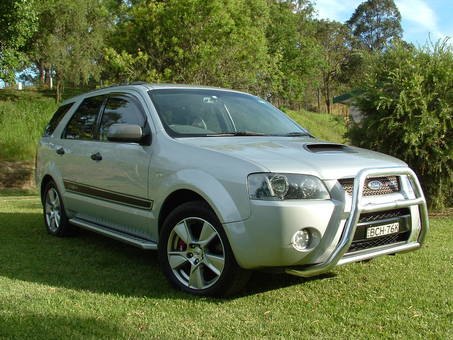TTAC Salutes The Ford Territory
While the Ford Falcon is getting the bulk of the attention with respect to Ford’s soon-to-be-shuttered Australian operations, Ford also made another product, based off the Falcon platform, that never made it to our shores. The Ford Territory might be the most desirable CUV ever made.
The FPV F6X (pictured above) borrowed the Falcon FPV6’s 362 horsepower turbocharged I6 but retained the Territory’s AWD system. 60 mph came up in about 6 seconds, but the FPV F6X had a big problem; a Falcon XR6T with a more powerful I6 engine was about 30 percent cheaper, and the F6X was barely distinguishable from the regular Territory Turbo. Sales were predictably slow and the F6X lasted one year only.
Although there were calls to export the Territory, nothing ever really got off the ground, and the Territory was left to its home market of Australia, as well as a handful of exports to right-hand drive countries like Thailand. At one time, there were even calls to send it to the United States, but it’s difficult to imagine American consumers caring enough about the rear-drive layout and I6 engine when it looked nearly identical to the Freestyle/Taurus X and carrying the price premium associated with being an Australian import.
I can’t help but feel saddened knowing that the Territory is marked for death along with the Falcon. The business case may no longer be there, but the Territory represents an increasingly rare-breed in the automotive world; a vehicle that was derived as a unique solution to local tastes and attitudes. The fact that it could give many sports cars a real fight in a drag race, while looking like an ordinary family hauler makes it even more bittersweet.
More by Derek Kreindler
Latest Car Reviews
Read moreLatest Product Reviews
Read moreRecent Comments
- Redapple2 Love the wheels
- Redapple2 Good luck to them. They used to make great cars. 510. 240Z, Sentra SE-R. Maxima. Frontier.
- Joe65688619 Under Ghosn they went through the same short-term bottom-line thinking that GM did in the 80s/90s, and they have not recovered say, to their heyday in the 50s and 60s in terms of market share and innovation. Poor design decisions (a CVT in their front-wheel drive "4-Door Sports Car", model overlap in a poorly performing segment (they never needed the Altima AND the Maxima...what they needed was one vehicle with different drivetrain, including hybrid, to compete with the Accord/Camry, and decontenting their vehicles: My 2012 QX56 (I know, not a Nissan, but the same holds for the Armada) had power rear windows in the cargo area that could vent, a glass hatch on the back door that could be opened separate from the whole liftgate (in such a tall vehicle, kinda essential if you have it in a garage and want to load the trunk without having to open the garage door to make room for the lift gate), a nice driver's side folding armrest, and a few other quality-of-life details absent from my 2018 QX80. In a competitive market this attention to detai is can be the differentiator that sell cars. Now they are caught in the middle of the market, competing more with Hyundai and Kia and selling discounted vehicles near the same price points, but losing money on them. They invested also invested a lot in niche platforms. The Leaf was one of the first full EVs, but never really evolved. They misjudged the market - luxury EVs are selling, small budget models not so much. Variable compression engines offering little in terms of real-world power or tech, let a lot of complexity that is leading to higher failure rates. Aside from the Z and GT-R (low volume models), not much forced induction (whether your a fan or not, look at what Honda did with the CR-V and Acura RDX - same chassis, slap a turbo on it, make it nicer inside, and now you can sell it as a semi-premium brand with higher markup). That said, I do believe they retain the technical and engineering capability to do far better. About time management realized they need to make smarter investments and understand their markets better.
- Kwik_Shift_Pro4X Off-road fluff on vehicles that should not be off road needs to die.
- Kwik_Shift_Pro4X Saw this posted on social media; “Just bought a 2023 Tundra with the 14" screen. Let my son borrow it for the afternoon, he connected his phone to listen to his iTunes.The next day my insurance company raised my rates and added my son to my policy. The email said that a private company showed that my son drove the vehicle. He already had his own vehicle that he was insuring.My insurance company demanded he give all his insurance info and some private info for proof. He declined for privacy reasons and my insurance cancelled my policy.These new vehicles with their tech are on condition that we give up our privacy to enter their world. It's not worth it people.”


































Comments
Join the conversation
I must say--TTAC is an almost irelevant car site.
My first thought on seeing that pic. Wrap that bumper in a pink material and the car would look like a dog with its tongue trying to lick its nose.